
About UsThe Numismatic Bibliomania Society is a non-profit organization promoting numismatic literature. For more information please see our web site at coinbooks.org SubscriptionsThose wishing to become new E-Sylum subscribers (or wishing to Unsubscribe) can go to the following web page link MembershipThere is a membership application available on the web site Membership Application To join, print the application and return it with your check to the address printed on the application. Membership is only $15 to addresses in the U.S., $20 for First Class mail, and $25 elsewhere. For those without web access, write to: David M. Sundman, Secretary/TreasurerNumismatic Bibliomania
Society AsylumFor Asylum mailing address changes and other membership questions, contact David at this email address: dsundman@LittletonCoin.com SubmissionsTo submit items for publication in The E-Sylum, just Reply to this message, or write to the Editor at this address: whomren@coinlibrary.com
BUY THE BOOK BEFORE THE COINYou won't regret it! |
- WAYNE'S WORDS: THE E-SYLUM DECEMBER 4, 2011
- SIXTH COPY OF THIAN'S REGISTER CONFIRMED
- 2003 INTERNATIONAL NUMISMATIC CONGRESS PROCEEDINGS ONLINE
- LECTURE: BOOK HISTORIANS AND NUMISMATISTS AND ROMAN COINS
- QUERY: COIN WORLD NUMISMATIC SCRAPBOOK SECTIONS
- QUERY: WHERE ARE THE INVASION OF LOUISVILLE VIDEOTAPES?
- ERIC NEWMAN CENTENNIAL MEDALS AVAILABLE
- MAJOR EARL 1836 GOBRECHT DOLLAR LETTER DISCOVERED
- DIGITIZING CORNELL'S COIN COLLECTION
- NOTES FROM E-SYLUM READERS: DECEMBER 4, 2011
- COAL SCRIP OF PACKARD, KENTUCKY
- ABC NEWS ITEM ON CENT HOARDING
- THE DETROIT MAYORâS MEDAL
- SELLING BOOKS BY THEIR GILDED COVERS
- INK RUBS OFF CANADA'S NEW POLYMER BANKNOTE
- INDIAN TEMPLE TREASURE BEING CATALOGUED
- WORLD'S SMALLEST BANKNOTE?
- CAMARO COVERED IN UAE COINS
- FEATURED WEB PAGE: THE BRITISH NEWSPAPER ARCHIVE
WAYNE'S WORDS: THE E-SYLUM DECEMBER 4, 2011

Many thanks to the Ancient World Online (AWOL) blog, for posting links to The E-Sylum archive. See: Open Access Journal: E-Sylum (ancientworldonline.blogspot.com/2011/11/opoen-acces-journal-e-sylum.html)
Among our new subscribers this week are L. Halliwell, Victoria Pate, and Giovanni Gallo. Welcome aboard! We have 1,477 email subscribers, plus 167 followers on Facebook.
This week we have NO new announcements of numismatic books! What gives? We've had a great run lately, but I've been getting used to it. Better luck next week. Topics we DO cover this week include a new discovery copy of a very rare book on U.S. numismatics, The Invasion of Louisville video tapes, and researching coal scrip.
To learn more about the world's smallest banknote, Major Earl's 1836 Gobrecht dollar, and Napoleon's "maltreated strip of buckskin shoelace", read on. Have a great week, everyone!
Wayne Homren
Numismatic Bibliomania Society
SIXTH COPY OF THIAN'S REGISTER CONFIRMED
 Itâs time to rewrite the history books on Confederate States finance, and the evolution of Confederate currency collecting. A sixth example of the desirable and rare, original 1880 Register of the Confederate Debt by Raphael P. Thian has been unearthed. This, the latest Thian to be added to the âcensusâ of âknown extantâ 1880 Registers, resides in a Virginia library, where it has languished unheralded collector-wise for the past 53 years.
Itâs time to rewrite the history books on Confederate States finance, and the evolution of Confederate currency collecting. A sixth example of the desirable and rare, original 1880 Register of the Confederate Debt by Raphael P. Thian has been unearthed. This, the latest Thian to be added to the âcensusâ of âknown extantâ 1880 Registers, resides in a Virginia library, where it has languished unheralded collector-wise for the past 53 years.
Last month we reported on the âpossibleâ existence of a sixth example of Raphael P. Thianâs original 1880 opus on Confederate paper money and bonds. News of this sixth original Thian was greeted by a range of responses within the CSA collecting community from jubilation to skepticism.
Now we can definitively go on the record. The newly discovered original Thian Register rests on the shelves of the Rare Book Room at the Virginia Historical Society, and has done so since the VHS purchased it in 1958 as part of a large acquisition of historical works from the library of a prominent Richmond attorney.
J. Wayne Hilton, owner of one of the greatest CSA currency collections of all time and possessor of the most recent example of an original Thian Register to cross the auction block (the John J. Ford example for which Hilton paid more than $35,000), welcomed the discovery. âI think this will be the greatest numismatic literature discovery of the past ??? years.⦠I cannot recall another scarce book being found in the past 50 or more years, so it might be greatest since 1880!â he told this writer.(1) Hilton further called the discovery and its confirmation âa major plus in the year of the 150th anniversary of Ft. Sumter.â(2)
For nearly 40 years collectors of Confederate currency have believed that Thianâs great work on the Rebel funded and unfunded debt, including his enumeration of most Rebel treasury note issues, was available in only five examples. We all have been led to believe that this was so because Dr. Douglas Ball told us that this was the case in his âForewordâ to the 1972 reprint edition of Thianâs Register.
âThianâs Register of Issues of Confederate States Treasury Notes Together with Tabular Exhibits of the Debt, Funded and Unfunded of the Confederate States of America 1861-1865 is a classic example of a rare book, there being only five copies extant,â Ball wrote in 1972.(3)
Unfortunately, to this writerâs certain knowledge, Ball never published his list of the five locations that he knew of four decades ago. Although he may have orally communicated these five locations to others, he never did so to me, and I actually cannot recall ever having broached the subject with him. If a reader or readers knows Ballâs actual published or oral views on this subject, I would be very pleased to receive same.
To read the complete article, see: Rare Confederate Tome Discovered (www.numismaster.com/ta/numis/Article.jsp?ad=article&ArticleId=24065)
2003 INTERNATIONAL NUMISMATIC CONGRESS PROCEEDINGS ONLINE
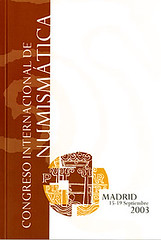 I don't recall seeing notice that the 2005 proceedings of the 2003 International Numismatic Congress held in Madrid were put online (apparently in their entirety!) in 2010:
I don't recall seeing notice that the 2005 proceedings of the 2003 International Numismatic Congress held in Madrid were put online (apparently in their entirety!) in 2010:
www.mcu.es/museos/MC/ActasNumis/
While the introductory material is in Spanish, authors were allowed to publish their articles in any language. Given the broad range of topics covered, many individuals may find it hard to justify buying these volumes for their library so it's very nice to able to have access to all the articles in PDF.
LECTURE: BOOK HISTORIANS AND NUMISMATISTS AND ROMAN COINS
On Thursday, February 9th, 2012 at 4:00 PM, Terry Belanger, Founder of the Rare Book School, University of Virginia will deliver a lecture in Los Angeles entitled:
âParallel Lines Never Meet: Dolphins and Anchors and Aldus, Book Historians and Numismatists and Roman Coinsâ
The William Andrews Clark Memorial Library, 2520 Cimarron Street (off Adams) Los Angeles, California 90018-2098 Telephone: 323-731-8529 www.humnet.ucla.edu/humnet/clarklib/
The presentation is open to all but it is necessary for attendees to send an RSVP in advance to c1718cs@humnet.ucla.edu and to specify that the reservation is for the Belanger lecture. You should expect a confirmation e-mail in response
THE BOOK BAZARRE
QUERY: COIN WORLD NUMISMATIC SCRAPBOOK SECTIONS
I want to say thanks to all who answered my question on the Tom Elder periodicals. Now I have another question. I was a subscriber to the Numismatic Scrapbook when it was sold to Coin World. The last issue was Feb 1976. Scrapbook subscriptions were changed to Coin World, or if you already subscribed to Coin World, your subscription was extended.
For a while however, starting March 1976, once a month, Coin World would publish a section of the paper titled "Coin World NUMISMATIC SCRAPBOOK". I saved some if I was interested in the articles within, but not all. The last one I have is the issue of March 1977. Does anyone know how long these special sections were printed, or have a complete set of them?
QUERY: WHERE ARE THE INVASION OF LOUISVILLE VIDEOTAPES?
During the 1988 A.N.A. convention in Cincinnati, there was a day long excursion made by several dozen bibliophiles to see the impressive Armand Champa library in Louisville, Ky. They even boarded the Greyhound bus that took them there that morning, later at 6:30 pm, to take them to Del Frisco's for dinner and then back to the Champa residence.
By all printed accounts, it was a most enjoyable event. The late Ken Lowe wrote up his insights in Out On A Limb, in the September, 1988, Vol. II, Number 3 issue. Ken's wit and humor related the "invasion" in grand style. Armand even had a photographer and videographer on site to record the "on-goings".
Does anyone know where these video tapes are located now?
David Sklow writes:
I did locate the copy I remembered. It will be in my February Sale - here is the description.
VHS Tape: Invasion of Louisville ANA Convention 1988.
The outer sleeve is inscribed as follows [in Champa's hand] - Copy Number 5 of Eleven made, for Remy Bourne Jan 3, 1990.
1-2-3-- Champa Family
4-- John Bergman
5-- Remy Bourne
6-- Barry Tayman
7-- Roger Persichelli
8-- George Kolbe
9-- Ken Lowe
10-- John J. Ford
11-- NO NAME
The top label on the tape reads - To My Friend Remy Bourne - Enjoy [signed] Armand Champa - Jan 4, 1990.
The side label reads - INVASION OF LOUISVILLE A.N.A. CONVENTION 1988.
From TIME.com:
People have been fixated on Napoleon's penis since Napoleon's doctor allegedly cut it off during his autopsy in 1821 and gave it to a priest in Corsica. The penis, which was not properly preserved, has been compared over the years to a piece of leather, a shriveled eel and to beef jerky. In 1927 when it went on display in Manhattan, TIME weighed in, comparing it to a "maltreated strip of buckskin shoelace." It's enough to give anyone a complex! In 1977, a urologist living in New Jersey purchased the modern-day relic for $3,000 and stored it under his bed until he died 30 years later. His daughter inherited Napoleon's penis and has fielded at least one $100,000 offer.
To read the complete article, see:
Napoleon's Penis
(www.time.com/time/specials/packages/article/0,28804,1988719
_1988728_1988695,00.html #ixzz1fF4NXnKD)
KOLBE & FANNING NUMISMATIC BOOKSELLERS WEBSITE
ERIC NEWMAN CENTENNIAL MEDALS AVAILABLE
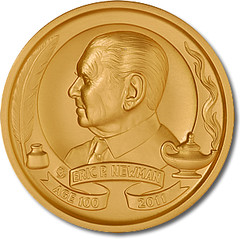
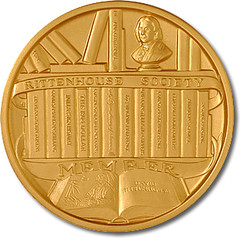
On the occasion of reaching life's centennial year, Eric Newman has also been honored for his numismatic books. Author of 13 notable works in the numismatic field, his family chose the theme of Eric's contribution to numismatic literature to appear on the numismatic works that chronicles the marvelous milestone this Saint Louis numismatist has reached.
The American Numismatic Society commissioned a plaquette be issued bearing Newman's portrait and a scene sitting in a library by a window on the reverse. The plaquette was created by Philadelphia sculptor Amy Kann.
The Rittenhouse Society of numismatic scholars of which Newman was an early member issued a more customary format of a circular medal. The obverse shows Newman facing left, reflective of looking into past history. The portrait is flanked by symbols of a quill pen and scholar's lamp, indicating his writing and educational efforts in the numismatic field.
The reverse not only shows the 13 books Newman wrote in his lifetime, but also carries their names on the spines.in raised lettering. One is in scrip lettering as on the spine of the published book.
Also on the reverse is a tiny statuette of David Rittenhouse and on the top shelf is an open book caring Rittenhouse's portrait from Charles Wilson Peale's painting in the exergue. The reverse was designed by Joel Iskowitz, seasoned designer of coins and medals. Both sides were modeled by sculptor Luigi S. Badia, also a seasoned artist in the medallic field.
The medals in bronze and silver were struck by Medallic Art Company of Dayton, Nevada. They were made from 14-inch models which allowed for exceptionally fine detail, particularly in the silver version which was rendered in full proof surface. The detail is so fine, a viewer can see the hairs in the eyebrows of the Rittenhouse portrait on the tiny statuette on the top shelf.
The bronze medals were given a special Old English patina, specially chosen to last for a 100 years. The patina was applied by Hugo Greco of Greco Industries of Bethel Connecticut.
Both bronze and silver are available, individually or as a set. Bronze $45, silver $245, the set $285, all postpaid. They can be ordered from Rittenhouse Society medal Chairman, Dick Johnson, 139 Thompson Drive, Torrington, CT 06790. He can be reached at dick.johnson@snet.net
MAJOR EARL 1836 GOBRECHT DOLLAR LETTER DISCOVERED
About a year ago an 1836 Gobrecht dollar came into the marketplace, eventually landing in the Heritage FUN sale in January 2011. Several months after the dollar was sold, the consignor found further information on the coin in her motherâs effects. The letter, from 1888, revealed that the dollar had been originally transmitted from a Major Earl to the family of the consignor.
Major Earl, it turns out, was a member of the Andrew Jackson household who effectively served as the âcourt painterâ to the Jackson family. There are other connections between President Jackson and numismatics, most notably a Gobrecht dollar presented at auction several years ago by American Numismatic Rarities, believed to have been Jacksonâs personal coin. An attendee at our meeting has acted as a go-between me and Heritage, our goal is to reunite the coin with this 1888 letter of transmittal. More will be posted as the story unfolds.
THE SECRET HISTORY OF THE FIRST U.S. MINT
DIGITIZING CORNELL'S COIN COLLECTION
Cornell University's coin collection is being digitized. Bill Rosenblum writes:
Here's an item thanks to my son Brian who is a digital specialist and the University of Kansas (and formerly at the University of Michigan).
Cornell's coin collection is one of the best-kept secrets on campus, but if archaeologist Annetta Alexandridis has her way, the world will soon have access to every one of its 1,500 coins. Thanks to the Grants Program for Digital Collections in Arts and Sciences, the coin collection will soon be digitized and its catalog posted online.
"Students love it when they can touch the coins, but that only works in a small class. In a larger class we use images, and it's definitely more thrilling for the students if an image is of a coin from our own collection," says Alexandridis, history of art assistant professor.
The Cornell coin collection ranks among the major university coin collections and covers the most important epochs of coin making in antiquity, from lumps of metal marked with a seal to beautifully crafted Byzantine gold stamped with royal faces. The collection boasts one of the first true coins, from 6th century B.C. Lydia -- it is shaped like a little bean, but made of gold.
"You can tell the history of Greek culture and the Roman Empire through these coins," says Alexandridis. She notes that many of the coins can also be viewed as artworks because the details are so finely wrought.
Ultimately the coins, currently stored in randomly sorted paper envelopes, will be put in museum-standard clear trays and reorganized for easier access.
According to Rhea Garen, library digital photo specialist, Cornell's Digital Consulting and Production Services will generate high-quality digital images of each coin by placing them directly on a flatbed scanner with adjustable focus. A rule will be included in each image to indicate size.
The ability to enlarge these images will enable Wilke to correct catalog errors easily. For example, with enlargement the image on a coin originally catalogued as a sphinx might be revealed to be a lion.
Metadata librarian Jason Kovari notes that digitization will be the quickest part of the process; he estimates the total project could easily take two years. About 300 of the coins have never been cataloged, so Wilke will have to identify each of them. "It's quite an undertaking," says Alexandridis. The images will be published online as they are completed."This project will help people realize how important this collection is, for every field, science and humanities," says Alexandridis. "Understanding is a physical process, and students need to have access to all sorts of objects, whether plow or coin or manuscript, as A.D. White understood so well."Digitizing the coins is another step toward creating a virtual museum containing all the university's collections, including its plaster casts, potsherds, lantern slides and bronzes, says Alexandridis. "These artifacts should be displayed. My vision is that this virtual museum will be such a success, it will lead to a new university museum."
To read the complete article, see:
Digitizing a best-kept secret: Cornell's coin collection
(www.rdmag.com/News/Feeds/2011/11/general-sciences
-digitizing-a-best-kept-secret-cornells-coin-colle/)
NOTES FROM E-SYLUM READERS: DECEMBER 4, 2011
Our Colored Heroes Medal Found
Derek Asklar writes:
I found one of these while medal detecting in central Florida two weeks ago. I was wondering if you were able to find more info on it. For those of us in the hobby finding a piece of history that has been forgotten by most people is an awesome feeling. I am attaching photos of the medal. Thank you for your time.
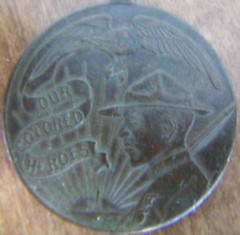
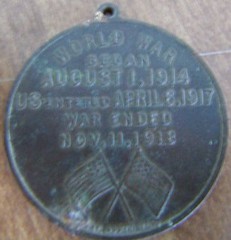
To read the earlier E-Sylum articles, see:
MYSTERY MEDAL FOR "OUR COLORED HEROES"
(www.coinbooks.org/esylum_v10n13a22.html)
WWI MEDAL FOR "OUR COLORED HEROES"
(www.coinbooks.org/esylum_v13n27a12.html)
MORE ON THE WWI MEDAL FOR "OUR COLORED HEROES"
(www.coinbooks.org/esylum_v13n28a09.html)
Correction: John Sallay's Address
John Sallay writes:
Thanks again for publishing my query on Athena/Minerva. My e-mail address is jsallay@comcast.net, not sallay@comcast.net, so either the readers with suggestions will get e-mails bouncing back or possibly some unsuspecting Comcast subscriber will be learning more than they ever wanted to know about Athena!
To read the earlier E-Sylum article, see: QUERY: ATHENA/MINERVA SYMBOLISM (www.coinbooks.org/esylum_v14n49a07.html)
The Act Authorizing Postage Currency
Joe Boling writes:
The law cited by Huntoon says nothing about postage currency. It says that postage and other stamps (presumably meaning revenue stamps) may be received for dues to the US not exceeding $5, and would be exchanged for US notes in amounts exceeding $5. Not a word there about postage currency. Is there some other statute that defines postage currency in a way that would make it "other stamps?"
Peter Huntoon responds:
Believe it or not, this act was used by Treasury to proceed with postage currency, and even award the contracts to the same bank note company that was making the stamps.
Well, if they considered the postage currency to be stamps, they would be justified in doing so - maybe that's exactly why it was called postage currency in the beginning.
To read the earlier E-Sylum article, see: QUERY: PREMIUMS PAID FOR POSTAGE AND FRACTIONAL CURRENCY (www.coinbooks.org/esylum_v14n49a11.html)
Comments on Coins of the Future
Regarding Dick Johnson's discussion of "Coins of the Future",
Michael E. Marotta writes:
It sounds fascinating and Johnson should consider publishing this. A blog or website at least as a doorway to a Google Documents archive is easy enough. I do offer a quibble. "...world economics has advanced so far to make the cent and nickel obsolete coins of commerce because of their low value." Actually, world economics has devolved so far as to make government moneys even more degraded than they were. I am often taken aback by the inroads not made by Austrian economics in numismatics which is easily the largest unregulated money market in the world. That aside, Johnson's expertise is solid enough that his proposals should be insightful and practical. I look forward to them.
To read the earlier E-Sylum article, see: DICK JOHNSON ON WORLD COINS OF THE FUTURE (www.coinbooks.org/esylum_v14n49a18.html)
COAL SCRIP OF PACKARD, KENTUCKY
Packard Kentucky was an enigma. Of the numismatic investigations that I have recently undertaken, chronicling the elusive story of this long-forgotten town has been quite formidable. Little but scant documentation remains of this place, and nary but two photographs of Packard were found during the course my research¹. It took weeks of archive research to locate the photos herein; not a single photograph of Packard existed publicly online until now.
A ghost-town long extinct, Packard exists only in the surviving memories of a few former inhabitants, a mere handful of faded snapshots, and but a smattering of arcane references in yellowed periodicals.
Packard began as little more than a mining camp; a hamlet established prior to the dawn of the 20th century. The town sat just 9 miles from the Tennessee border in Whitley County, nestled among the Cumberland Mountains². Named in honor of Mary Amelia Packard, a local schoolteacher, the little town sprouted in a sleepy corner of southeast Kentucky coal country.
As with most coal towns, everyday life centered around mining activities, and the companies which provided the locals with their livelihoods. As long as the mines remained open, the "Company" town existed. But when the coal seams inevitably exhausted, so too was the rationale for the towns, and they would inexorably evaporate. This too was the story of Packard.
From its genesis in the late 19th century until its demise a few years after World War II, the town of Packard hosted three coal companies. By far the largest employer was the Mahan Jellico Coal Company, with upwards of 200 employees during the height of its operations. Two other coal companies, the Polley Coal Company and later the Booth Blue Gem Coal Company, also conducted mining operations in the area. At the town's apex, as many as 250 workers were employed by these coal companies.
Pictured below are three token specimens from my cabinet, issued for the town of Packard⁸. These tokens, known as âcoal scrip', were issued to employees and their families as means of credit, and for the purchase of goods at Mahan-Jellico's Company Store.
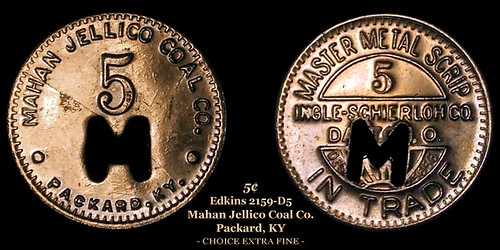
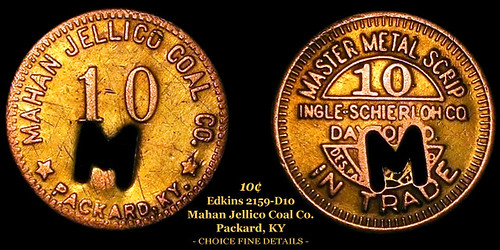
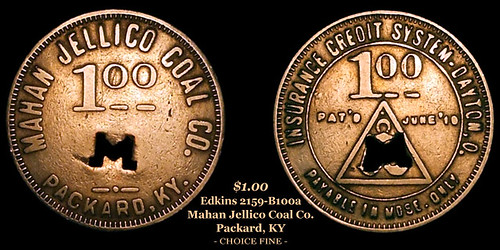
To read the complete article, see: The Elusive Story of Packard Kentucky and its Scrip (www.coincommunity.com/forum/topic.asp?TOPIC_ID=86436)
THE BOOK BAZARRE
ABC NEWS ITEM ON CENT HOARDING
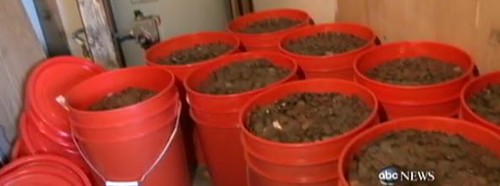
Joe Henry is on a first name basis with bank tellers across his hometown of Medford, Ore., scouring 15 banks a week with one thing on his mind: pennies.
Henry is often seen toting around bags of pennies, some he buys, others he changes back in for cash, which seems a little strange at first. He's not a collector, he is what's known as a "penny hoarder" and he is not alone.
Inside a shed next to his house, Henry has orange tubs filled with 200,000 pennies, and he spends hours sorting through roll after roll of the coins. But it's not just any and all pennies, Henry is only interested in those that are dated from 1982 and earlier because those are the coins made with 95 percent copper. A copper penny is worth more than other pennies -- now mostly made of zinc -- currently priced at $0.024.
"The copper has such a different sound than zinc pennies do," Henry said. "Real money has that definite sound of money and if you listen to a modern zinc penny, they don't sound the same, they sound sort of tinny."
Henry even has a $500 home counting machine to separate out the copper ones.
Much like the resurging obsession with gold, the price of copper has skyrocketed in recent years and the rising price has led to some unusual sprees. Thieves have been exploiting the value hidden in obscure items, stripping copper wiring from phone and utility cables, from construction sites, even from a 122-year-old copper bell that was stolen from a San Francisco cathedral.
But penny hoarders aren't thieves, just opportunists. There are a slew of listing for pennies in bulk on eBay, but what's amazing is they include listings for $10 in pennies being sold for $20 dollars. If you think only a sucker would pay two cents for a penny, you're missing out on a business opportunity that Adam Youngs, who runs a massive penny sorting operation in Portland, Ore., has perfected.
He explained how he can sell a $100 worth of pennies for $176, when shipping and packaging are included.
Youngs' operation, the Portland Mint, is locked inside a secure facility that deals with armored cars -- selling and shipping to clients in every state -- and works in pennies by the ton. He said he has clients with deep pockets who are storing huge sacks of pennies and he has inquires from hedge funds.
"Just in face value alone, about $270,000 dollars [in pennies] right now," Youngs said. "That is just the face value, that is not even the copper value. The copper value is about three times that much."
Clients use Youngs because he separates copper pennies from the chump change -- the newer pennies that are only worth $0.01.
But in the weird world of penny hoarding, getting to the copper is a very big problem. It's illegal to melt pennies an there is an obscure federal law that makes it illegal to transport more than $5 in pennies out of the country.
Penny hoarders know this of course, but they also know something else. In what could be the biggest legislation to hit the U.S. Mint in 50 years, officials are now looking at the composition of pennies and nickels and considering an overhaul. If the laws change and the mint decides to abolish the penny, people would be free to melt them down for the copper.
A penny saved, many times over, could be a whole lot earned.
To read the complete article, see:
If Laws Change, 'Penny Hoarders' Could Cash in on Thousands of Dollars
(abcnews.go.com/Business/laws-change-penny-hoarders
-cash-thousands-dollars/story?id=15076522#.Ttwi5GNFu7u)

To view the video, see: (blog.cgpgrey.com/death-to-pennies/)
THE DETROIT MAYORâS MEDAL

DETROIT MAYORâS MEDAL, 1963. 63.4mm. Bronze. Marshall Fredericks, Sc. (MACO). Uncirculated with some light discoloration on the reverse as shown. . The obverse is a depiction of the seal of the city containing a representation of the Detroit fire in which the entire city burned with only one building saved from the flames. The figure of the left weeps over the destruction while the figure on the right gestures to the new city that will rise in its place. The two line Latin inscription at center reads: SPERAMVS RESVRGET/ MELIORA CINERIBVS (âWe Hope For Better Things; It Shall Rise From the Ashesâ) The reverse is inscribed SPIRIT OF DETROIT above a replication of Frederickâs statue of the same name; a 26 foot figure holding a globe which is one of the most recognized monuments in the city.
SELLING BOOKS BY THEIR GILDED COVERS
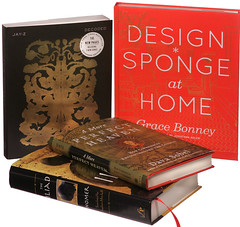 Even as more readers switch to the convenience of e-books, publishers are giving old-fashioned print books a makeover.
Even as more readers switch to the convenience of e-books, publishers are giving old-fashioned print books a makeover.
Many new releases have design elements usually reserved for special occasions â" deckle edges, colored endpapers, high-quality paper and exquisite jackets that push the creative boundaries of bookmaking. If e-books are about ease and expedience, the publishers reason, then print books need to be about physical beauty and the pleasures of owning, not just reading.
âWhen people do beautiful books, theyâre noticed more,â said Robert S. Miller, the publisher of Workman Publishing. âItâs like sending a thank-you note written on nice paper when weâre in an era of e-mail correspondence.â
The eagerly anticipated 925-page novel by Haruki Murakami, â1Q84,â arrived in bookstores in October wrapped in a translucent jacket with the arresting gaze of a young woman peering through. A new novel by Stephen King about the Kennedy assassination, â11/22/63,â has an intricate book jacket and, unusual for fiction, photographs inside. The paperback edition of Jay-Zâs memoir âDecodedâ features a shiny gold Rorschach on the cover, and in March the front of âThe Song of Achillesâ by Madeline Miller will bear an embossed helmet sculpted with punctures, cracks and texture, giving the image a 3-D effect.
Publishers in recent years have had a frugal attitude about so-called special effects, but that attitude has begun to shift, said Julie Grau, senior vice president and publisher of Spiegel & Grau, part of Random House.
âWeâre rethinking the value in certain cases of special effects and higher production standards,â Ms. Grau said, citing âDecoded.â
âNow in some cases, creating a more beautiful hardcover or paperback object is warranted.â
For publishers, the strategy has a clear payoff: to increase the value of print books and build a healthy, diverse marketplace that includes brick-and-mortar bookstores and is not dominated by Amazon and e-books.
To read the complete article, see:
Selling Books by Their Gilded Covers
(www.nytimes.com/2011/12/04/books/publishers-gild
-books-with-special-effects-to-compete-with-e-books.html)
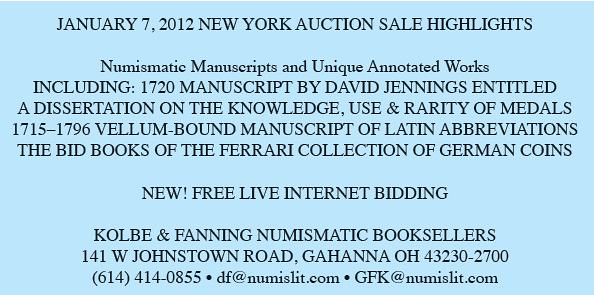
INK RUBS OFF CANADA'S NEW POLYMER BANKNOTE
 The Bank of Canada's new $100 polymer note has undergone rigorous testing.
It has been subjected to extreme heat and cold. Run through washing machines and is touted to last two-and-a-half times longer than paper notes. But one thing the Bank of Canada's staff of scientists may not have checked when testing the notes is busy hands.
The Bank of Canada's new $100 polymer note has undergone rigorous testing.
It has been subjected to extreme heat and cold. Run through washing machines and is touted to last two-and-a-half times longer than paper notes. But one thing the Bank of Canada's staff of scientists may not have checked when testing the notes is busy hands.
A new $100 note was brought into the Journal Pioneer office this week by a local resident. He said he received the bill from a friend who had written someone's name on it. He began rubbing at the pen ink to remove it and discovered the images on the $100 polymer note came off as well. He said after about 15 minutes the bill was nearly unrecognizable.
Portraits of prime minster Robert Borden disappeared, as did the Peace Tower. Julie Girard, currency spokesperson for the Bank of Canada, said extreme care is taken when developing new notes and that rubbing a bill between someone's hands is beyond what the bill was designed for. It's not what is considered "normal wear and tear."
"What we ask Canadians to do is to treat these new notes as they would the paper notes that all of us are used to using," Girard said. "This wear and tear that I have noticed on the note is not, that I can see, normal wear."
While these bills will be handled on many separate occasions by shoppers, merchants and banks, Girard said this is what is considered normal.
"They will (be handled) and under the normal handling of passing a note back and forth the notes will last. But if it's rubbed for a long period of time, for 15 minutes, rubbing it for 15 minutes continuously, is not a normal use of the note and it will potentially wear faster," Girard said. "If Canadians use them the way they should . . . they are actually the most secure notes in the world." The Bank of Canada goes to great lengths to insure new notes are secure and durable, she said.
"When we put out a note it's a process that doesn't take months, it actually takes years," Girard said. "At the Bank of Canada we have scientists. We have chemists. We have physicists. We have all kinds of specialists who work on the development of the bank note and they're part of our research and development team."
To read the complete article, see:
Careful with that new bill
(www.journalpioneer.com/News/Local/2011-12-01
/article-2822658/Careful-with-that-new-bill/1)
INDIAN TEMPLE TREASURE BEING CATALOGUED
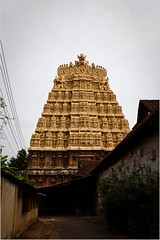 The Tirumala Tirupati Devasthanam (TTD), the body which runs the affairs of the countryâs richest temple, has initiated an exercise to assess the value and antiquity of nearly 18 tonnes of old Indian and foreign coins, several of them from Arab countries, collected in its hundis (donation boxes) over the past years.
TTD Executive Officer L V Subramanyam said a team of numismatists â" coin experts â" have been pressed into service to assess their value for disposal at a later date after taking into account its antiquity. âThe coin experts drawn from Archeological Survey of India and the state archeology have already begun the exercise and are expected to complete the scrutiny and assessment by November 29,â he said.
The Tirumala Tirupati Devasthanam (TTD), the body which runs the affairs of the countryâs richest temple, has initiated an exercise to assess the value and antiquity of nearly 18 tonnes of old Indian and foreign coins, several of them from Arab countries, collected in its hundis (donation boxes) over the past years.
TTD Executive Officer L V Subramanyam said a team of numismatists â" coin experts â" have been pressed into service to assess their value for disposal at a later date after taking into account its antiquity. âThe coin experts drawn from Archeological Survey of India and the state archeology have already begun the exercise and are expected to complete the scrutiny and assessment by November 29,â he said.
Stating that the huge stock of coins were being categorised on the basis of metal, country and size, he said the coins were made from copper, bronze and steel and had its origins in countries like the US, Malaysia, Singapore, Sri Lanka, Australia, New Zealand, United Kingdom, South Africa, Canada, Nepal, Thailand and Arab countries. âThe foreign origin coins weigh approximately six tonnes,â he said.
Subramanayam said that based on the number of antique coins, the TTD was mulling over a programme to set up galleries in prominent museums across the country for display of its coin collection. âWe want to utilise the opportunity to showcase Sanatana Dharma through coins by setting up such galleries in museums across the country,â he said.
The TTD has also taken up cleaning of copper plates containing Annamaiah kirtans composed by saint poet Tallapaka Annamacharya (1408-1503), who had penned over 32,000 kirtans in praise of Lord Venkateswara. These kirtans were engraved on 2698 copper plates by his son Tallapaka Pedda Tirumalacharya and were preserved in sanctum sanctorum of Tirumala shrine.
Meanwhile, according to preliminary estimates, the value of 162 precious stones, mostly diamonds, which were offered by an unknown devotee last week, would be around Rs15 million.
âThe exact figure would be known only after the evaluation report is received from the jewellery section of the TTD,â Subramanyam said, adding that a purchase certificate of the precious stones was also found in the hundi along with the precious stones.
To read the complete article, see:
Value, antiquity of 18 tonnes of temple coins being assessed
(www.khaleejtimes.com/DisplayArticleNew.asp?section=international
&xfile=data/international/2011/november/international_november1021.xml)
WORLD'S SMALLEST BANKNOTE?
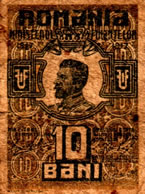 The 10-bani note of the Ministry of Finance of Romania issued in 1917 (emergency WW I issue) measured (printed area) 27.5 x 38 mm (1.08 x 1.49 in) - setting the world record for the Smallest paper money, according to World Records Academy (www.worldrecordsacademy.org).
The 10-bani note of the Ministry of Finance of Romania issued in 1917 (emergency WW I issue) measured (printed area) 27.5 x 38 mm (1.08 x 1.49 in) - setting the world record for the Smallest paper money, according to World Records Academy (www.worldrecordsacademy.org).
To read the complete article, see:
Smallest paper money: Romanian 10-bani note sets world record
(www.worldrecordsacademy.org/business/smallest_paper
_money_Romanian_10-bani_note_sets_world_record_112605.html)
CAMARO COVERED IN UAE COINS

We have earlier seen all sorts of products getting the precious bling treatment and later hailed as âWorldâs most expensiveâ but every inch of a car glued with coins seems to be rare. Here is the 1999-make Chevrolet Camaro vehicle which is fully covered with UAE coins to celebrate the 40th UAE National Day. Hailed as âPride of Emiratesâ, this one-of-a-kind decked up car was put together by Tarek Javaid who has long served in the automobiles industry and hopes to enter the Guinness World Records with this one.
Just like they say that Rome wasnât built in one day, it took the Pakistani man as much as 3,000 hours to glue 33,000 coins on the car. Javaid has further conceded that he wants to donate the car to UAE on this prestigious occasion. Both residents and tourists in Dubai can catch a glimpse of this shiny car made up of Dh1, 50 fils, 25 fils, 10 fils, 5 fils and 1 fils coins at Al Ghandi Auto on Shaikh Zayed Road. Being far less obnoxious than all those gold plated cars we have seen before, this verison of Camaro will surely become a long cherished middle-eastern relic.
To read the complete article, see:
Chevrolet Camaro decked with coins celebrates 40th National Day of UAE
(www.businessinsider.com/chevrolet-camaro-decked
-with-coins-celebrates-40th-national-day-of-uae-2011-11)
FEATURED WEB PAGE: THE BRITISH NEWSPAPER ARCHIVE
This week's Featured Web Page is the British Newspaper Archive, suggested by Stephen Pradier.Whether you are a researcher, historian or you simply want to know more about Britain's history, take this fantastic opportunity to search this vast treasure trove of historical newspapers from your own home.
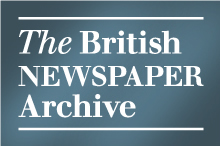
www.britishnewspaperarchive.co.uk/ a
